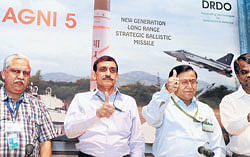India can use its 5,000-km range Agni V missile to inject satellites in a low earth orbit at an altitude of 600-800 km to restore communication links, in the event of the country being denied access to its satellite constellations by the enemy.

A second variant of Agni V could be used to destroy enemy satellites in the low earth orbit.
A third version could be tailored to carry a multiple independently targetable reentry vehicle (MIRV) in which a single rocket can be used to launch many war heads on multiple enemy targets, rendering the missile defence system useless.
“Agni V can be used to launch mini-satellites in low earth orbits in a theatre battlefield when your major satellite constellation is denied,” said V K Saraswat, scientific adviser to the defence minister and Director-General of Defence Research and Development Organisation (DRDO).
However, these satellites will have short life span—between six months and one year—and have a specific purpose like restoring the communication links in an emergency situation.
A day after the successful maiden launch of Agni V, Saraswat said the three-stage rocket could be modified to make it an anti-satellite weapon though India strongly opposed any move towards weaponisation of space.
“Agni V gives us boosting capability (using booster rockets) to reach an altitude of 800 km and guidance for homing in on the satellite. We can use kinetic energy to destroy the payload or use shrapnel targeting the satellite. The tracking network is also in place,” he said.
The DRDO chief, however, refused to disclose Agni V’s actual range. “It is more than 5,000 km. I cannot give you the exact range. That's classified,” he said. Asked whether Agni V could be described as an inter-continental ballistic missile, Saraswat said he would prefer to describe it as a long-range ballistic missile.
The nuclear tipped missile, however, fits the criterion of an ICBM as it can reach other continents—Europe or Africa—when launched from India.
The Cabinet sanction for Agni V was accorded in December 2008. The government set a time frame of four years for the missile. The first flight happened within that time frame.
The Defence Research and Development Organisation keeps Agni V project cost under
wraps, though each of these missiles cost between Rs 60 crore and Rs 80 crore. Asked about the project cost sanctioned by the government, Agni programme director and chief controller (missile systems) Avinash Chander told Deccan Herald that the Cabinet approval on cost was a classified information.
Single warhead
Chander clarified that Agni V in its current configuration is a “single warhead” system as MIRV was still under development. The MIRV would draw heavily on Agni V.
Saraswat said India had no plan to cap the Agni programme. “There will be more Agni (presumably with increasing range) after Agni V. We don’t worry about other countries having missiles with longer range,” he said adding that two more tests of Agni V were required for validation before Agni V went to the production phase.